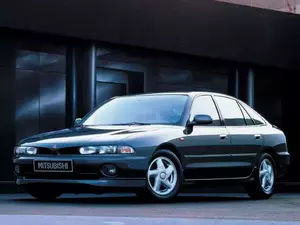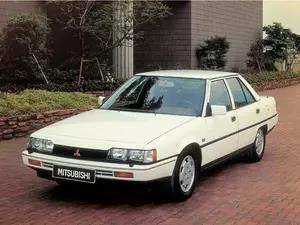
| Vehicle | Precise engine size | Difference from world average | Engine size to consumption ratio | Horsepower from 1 L | Engine size to 100 kg of weight |
|---|---|---|---|---|---|
| 3.8 V6 |
3.83 L (3828 cc) |
63.2% bigger | - | 67 hp from 1 L | 239 cc to 100 kg |
| 2.4 i 16V |
2.38 L (2378 cc) |
1.4% bigger | 95 cc to 1 mpg | 66 hp from 1 L | 149 cc to 100 kg |
| Vehicle | 3.8 V6 |
|---|---|
| Precise engine size | 3.83 L (3828 cc) |
| Difference from world average | 63.2 bigger |
| Engine size to consumption ratio | - |
| Horsepower from 1 L | 67 hp from 1 L |
| Engine size to 100 kg of weight | 239 cc to 100 kg |
| Vehicle | 2.4 i 16V |
| Precise engine size | 2.38 L (2378 cc) |
| Difference from world average | 1.4 bigger |
| Engine size to consumption ratio | 95 cc to 1 mpg |
| Horsepower from 1 L | 66 hp from 1 L |
| Engine size to 100 kg of weight | 149 cc to 100 kg |

| Vehicle | Precise engine size | Difference from world average | Engine size to consumption ratio | Horsepower from 1 L | Engine size to 100 kg of weight |
|---|---|---|---|---|---|
| 2.5 i V6 24V |
2.5 L (2498 cc) |
6.5% bigger | - | 65 hp from 1 L | 167 cc to 100 kg |
| 2.0 i |
2 L (1998 cc) |
14.8% smaller | - | 67 hp from 1 L | - |
| 2.4 i |
2.35 L (2351 cc) |
0.2% bigger | - | 64 hp from 1 L | - |
| Vehicle | 2.5 i V6 24V |
|---|---|
| Precise engine size | 2.5 L (2498 cc) |
| Difference from world average | 6.5 bigger |
| Engine size to consumption ratio | - |
| Horsepower from 1 L | 65 hp from 1 L |
| Engine size to 100 kg of weight | 167 cc to 100 kg |
| Vehicle | 2.0 i |
| Precise engine size | 2 L (1998 cc) |
| Difference from world average | 14.8 smaller |
| Engine size to consumption ratio | - |
| Horsepower from 1 L | 67 hp from 1 L |
| Engine size to 100 kg of weight | - |
| Vehicle | 2.4 i |
| Precise engine size | 2.35 L (2351 cc) |
| Difference from world average | 0.2 bigger |
| Engine size to consumption ratio | - |
| Horsepower from 1 L | 64 hp from 1 L |
| Engine size to 100 kg of weight | - |

| Vehicle | Precise engine size | Difference from world average | Engine size to consumption ratio | Horsepower from 1 L | Engine size to 100 kg of weight |
|---|---|---|---|---|---|
| 2.5 24V |
2.5 L (2498 cc) |
6.5% bigger | 81 cc to 1 mpg | 65 hp from 1 L | 178 cc to 100 kg |
| 2.5 i VR-4 Type-V 4WD |
2.5 L (2498 cc) |
6.5% bigger | - | 112 hp from 1 L | 167 cc to 100 kg |
| 2.0 GDi 16V |
2 L (1999 cc) |
14.8% smaller | - | 68 hp from 1 L | 154 cc to 100 kg |
| 2.0 |
2 L (1997 cc) |
14.9% smaller | 71 cc to 1 mpg | 68 hp from 1 L | 154 cc to 100 kg |
| 1.8i |
1.83 L (1834 cc) |
21.8% smaller | - | 82 hp from 1 L | 141 cc to 100 kg |
| 2.4 GDI |
2.35 L (2351 cc) |
0.2% bigger | - | 64 hp from 1 L | 181 cc to 100 kg |
| 2.0 TDI |
2 L (1998 cc) |
14.8% smaller | - | 45 hp from 1 L | 154 cc to 100 kg |
| 3.0 i V6 24V GTZ |
2.97 L (2972 cc) |
26.7% bigger | 149 cc to 1 mpg | 66 hp from 1 L | 198 cc to 100 kg |
| Vehicle | 2.5 24V |
|---|---|
| Precise engine size | 2.5 L (2498 cc) |
| Difference from world average | 6.5 bigger |
| Engine size to consumption ratio | 81 cc to 1 mpg |
| Horsepower from 1 L | 65 hp from 1 L |
| Engine size to 100 kg of weight | 178 cc to 100 kg |
| Vehicle | 2.5 i VR-4 Type-V 4WD |
| Precise engine size | 2.5 L (2498 cc) |
| Difference from world average | 6.5 bigger |
| Engine size to consumption ratio | - |
| Horsepower from 1 L | 112 hp from 1 L |
| Engine size to 100 kg of weight | 167 cc to 100 kg |
| Vehicle | 2.0 GDi 16V |
| Precise engine size | 2 L (1999 cc) |
| Difference from world average | 14.8 smaller |
| Engine size to consumption ratio | - |
| Horsepower from 1 L | 68 hp from 1 L |
| Engine size to 100 kg of weight | 154 cc to 100 kg |
| Vehicle | 2.0 |
| Precise engine size | 2 L (1997 cc) |
| Difference from world average | 14.9 smaller |
| Engine size to consumption ratio | 71 cc to 1 mpg |
| Horsepower from 1 L | 68 hp from 1 L |
| Engine size to 100 kg of weight | 154 cc to 100 kg |
| Vehicle | 1.8i |
| Precise engine size | 1.83 L (1834 cc) |
| Difference from world average | 21.8 smaller |
| Engine size to consumption ratio | - |
| Horsepower from 1 L | 82 hp from 1 L |
| Engine size to 100 kg of weight | 141 cc to 100 kg |
| Vehicle | 2.4 GDI |
| Precise engine size | 2.35 L (2351 cc) |
| Difference from world average | 0.2 bigger |
| Engine size to consumption ratio | - |
| Horsepower from 1 L | 64 hp from 1 L |
| Engine size to 100 kg of weight | 181 cc to 100 kg |
| Vehicle | 2.0 TDI |
| Precise engine size | 2 L (1998 cc) |
| Difference from world average | 14.8 smaller |
| Engine size to consumption ratio | - |
| Horsepower from 1 L | 45 hp from 1 L |
| Engine size to 100 kg of weight | 154 cc to 100 kg |
| Vehicle | 3.0 i V6 24V GTZ |
| Precise engine size | 2.97 L (2972 cc) |
| Difference from world average | 26.7 bigger |
| Engine size to consumption ratio | 149 cc to 1 mpg |
| Horsepower from 1 L | 66 hp from 1 L |
| Engine size to 100 kg of weight | 198 cc to 100 kg |

| Vehicle | Precise engine size | Difference from world average | Engine size to consumption ratio | Horsepower from 1 L | Engine size to 100 kg of weight |
|---|---|---|---|---|---|
| 2.0 TDI |
2 L (1998 cc) |
14.8% smaller | - | 45 hp from 1 L | 143 cc to 100 kg |
| 2.0 |
2 L (1997 cc) |
14.9% smaller | - | 68 hp from 1 L | 154 cc to 100 kg |
| 2.4 GDI |
2.35 L (2351 cc) |
0.2% bigger | - | 64 hp from 1 L | 168 cc to 100 kg |
| 2.5 24V |
2.5 L (2498 cc) |
6.5% bigger | - | 65 hp from 1 L | 192 cc to 100 kg |
| 2.4 GDi 16V |
2.35 L (2351 cc) |
0.2% bigger | - | 60 hp from 1 L | 181 cc to 100 kg |
| Vehicle | 2.0 TDI |
|---|---|
| Precise engine size | 2 L (1998 cc) |
| Difference from world average | 14.8 smaller |
| Engine size to consumption ratio | - |
| Horsepower from 1 L | 45 hp from 1 L |
| Engine size to 100 kg of weight | 143 cc to 100 kg |
| Vehicle | 2.0 |
| Precise engine size | 2 L (1997 cc) |
| Difference from world average | 14.9 smaller |
| Engine size to consumption ratio | - |
| Horsepower from 1 L | 68 hp from 1 L |
| Engine size to 100 kg of weight | 154 cc to 100 kg |
| Vehicle | 2.4 GDI |
| Precise engine size | 2.35 L (2351 cc) |
| Difference from world average | 0.2 bigger |
| Engine size to consumption ratio | - |
| Horsepower from 1 L | 64 hp from 1 L |
| Engine size to 100 kg of weight | 168 cc to 100 kg |
| Vehicle | 2.5 24V |
| Precise engine size | 2.5 L (2498 cc) |
| Difference from world average | 6.5 bigger |
| Engine size to consumption ratio | - |
| Horsepower from 1 L | 65 hp from 1 L |
| Engine size to 100 kg of weight | 192 cc to 100 kg |
| Vehicle | 2.4 GDi 16V |
| Precise engine size | 2.35 L (2351 cc) |
| Difference from world average | 0.2 bigger |
| Engine size to consumption ratio | - |
| Horsepower from 1 L | 60 hp from 1 L |
| Engine size to 100 kg of weight | 181 cc to 100 kg |

| Vehicle | Precise engine size | Difference from world average | Engine size to consumption ratio | Horsepower from 1 L | Engine size to 100 kg of weight |
|---|---|---|---|---|---|
| 2.0 V6-24 |
2 L (1999 cc) |
14.8% smaller | 77 cc to 1 mpg | 75 hp from 1 L | 143 cc to 100 kg |
| 2.0 GLSI |
2 L (1997 cc) |
14.9% smaller | 71 cc to 1 mpg | 69 hp from 1 L | 154 cc to 100 kg |
| 1.8 |
1.83 L (1834 cc) |
21.8% smaller | 59 cc to 1 mpg | 63 hp from 1 L | 141 cc to 100 kg |
| 2.0 GLSTD |
2 L (1998 cc) |
14.8% smaller | 57 cc to 1 mpg | 45 hp from 1 L | 154 cc to 100 kg |
| 2.5 V6-24 4x4 |
2.5 L (2497 cc) |
6.4% bigger | 114 cc to 1 mpg | 68 hp from 1 L | 166 cc to 100 kg |
| Vehicle | 2.0 V6-24 |
|---|---|
| Precise engine size | 2 L (1999 cc) |
| Difference from world average | 14.8 smaller |
| Engine size to consumption ratio | 77 cc to 1 mpg |
| Horsepower from 1 L | 75 hp from 1 L |
| Engine size to 100 kg of weight | 143 cc to 100 kg |
| Vehicle | 2.0 GLSI |
| Precise engine size | 2 L (1997 cc) |
| Difference from world average | 14.9 smaller |
| Engine size to consumption ratio | 71 cc to 1 mpg |
| Horsepower from 1 L | 69 hp from 1 L |
| Engine size to 100 kg of weight | 154 cc to 100 kg |
| Vehicle | 1.8 |
| Precise engine size | 1.83 L (1834 cc) |
| Difference from world average | 21.8 smaller |
| Engine size to consumption ratio | 59 cc to 1 mpg |
| Horsepower from 1 L | 63 hp from 1 L |
| Engine size to 100 kg of weight | 141 cc to 100 kg |
| Vehicle | 2.0 GLSTD |
| Precise engine size | 2 L (1998 cc) |
| Difference from world average | 14.8 smaller |
| Engine size to consumption ratio | 57 cc to 1 mpg |
| Horsepower from 1 L | 45 hp from 1 L |
| Engine size to 100 kg of weight | 154 cc to 100 kg |
| Vehicle | 2.5 V6-24 4x4 |
| Precise engine size | 2.5 L (2497 cc) |
| Difference from world average | 6.4 bigger |
| Engine size to consumption ratio | 114 cc to 1 mpg |
| Horsepower from 1 L | 68 hp from 1 L |
| Engine size to 100 kg of weight | 166 cc to 100 kg |

| Vehicle | Precise engine size | Difference from world average | Engine size to consumption ratio | Horsepower from 1 L | Engine size to 100 kg of weight |
|---|---|---|---|---|---|
| 2.0 V6-24 |
2 L (1999 cc) |
14.8% smaller | 77 cc to 1 mpg | 75 hp from 1 L | 154 cc to 100 kg |
| 2.0 GLSI 4x4 |
2 L (1997 cc) |
14.9% smaller | - | 69 hp from 1 L | 182 cc to 100 kg |
| 2.0 GLSI |
2 L (1997 cc) |
14.9% smaller | 71 cc to 1 mpg | 69 hp from 1 L | 154 cc to 100 kg |
| 1.8 GLSI |
1.83 L (1834 cc) |
21.8% smaller | - | 69 hp from 1 L | - |
| 1.8 |
1.83 L (1834 cc) |
21.8% smaller | 59 cc to 1 mpg | 63 hp from 1 L | 153 cc to 100 kg |
| 1.8 i |
1.83 L (1829 cc) |
22% smaller | - | 74 hp from 1 L | 152 cc to 100 kg |
| 2.0 24 V V6 T |
2 L (1998 cc) |
14.8% smaller | - | 120 hp from 1 L | 143 cc to 100 kg |
| 2.0 GLSTD |
2 L (1998 cc) |
14.8% smaller | 57 cc to 1 mpg | 45 hp from 1 L | 154 cc to 100 kg |
| 2.5 V6-24 4x4 |
2.5 L (2497 cc) |
6.4% bigger | 114 cc to 1 mpg | 68 hp from 1 L | 166 cc to 100 kg |
| Vehicle | 2.0 V6-24 |
|---|---|
| Precise engine size | 2 L (1999 cc) |
| Difference from world average | 14.8 smaller |
| Engine size to consumption ratio | 77 cc to 1 mpg |
| Horsepower from 1 L | 75 hp from 1 L |
| Engine size to 100 kg of weight | 154 cc to 100 kg |
| Vehicle | 2.0 GLSI 4x4 |
| Precise engine size | 2 L (1997 cc) |
| Difference from world average | 14.9 smaller |
| Engine size to consumption ratio | - |
| Horsepower from 1 L | 69 hp from 1 L |
| Engine size to 100 kg of weight | 182 cc to 100 kg |
| Vehicle | 2.0 GLSI |
| Precise engine size | 2 L (1997 cc) |
| Difference from world average | 14.9 smaller |
| Engine size to consumption ratio | 71 cc to 1 mpg |
| Horsepower from 1 L | 69 hp from 1 L |
| Engine size to 100 kg of weight | 154 cc to 100 kg |
| Vehicle | 1.8 GLSI |
| Precise engine size | 1.83 L (1834 cc) |
| Difference from world average | 21.8 smaller |
| Engine size to consumption ratio | - |
| Horsepower from 1 L | 69 hp from 1 L |
| Engine size to 100 kg of weight | - |
| Vehicle | 1.8 |
| Precise engine size | 1.83 L (1834 cc) |
| Difference from world average | 21.8 smaller |
| Engine size to consumption ratio | 59 cc to 1 mpg |
| Horsepower from 1 L | 63 hp from 1 L |
| Engine size to 100 kg of weight | 153 cc to 100 kg |
| Vehicle | 1.8 i |
| Precise engine size | 1.83 L (1829 cc) |
| Difference from world average | 22 smaller |
| Engine size to consumption ratio | - |
| Horsepower from 1 L | 74 hp from 1 L |
| Engine size to 100 kg of weight | 152 cc to 100 kg |
| Vehicle | 2.0 24 V V6 T |
| Precise engine size | 2 L (1998 cc) |
| Difference from world average | 14.8 smaller |
| Engine size to consumption ratio | - |
| Horsepower from 1 L | 120 hp from 1 L |
| Engine size to 100 kg of weight | 143 cc to 100 kg |
| Vehicle | 2.0 GLSTD |
| Precise engine size | 2 L (1998 cc) |
| Difference from world average | 14.8 smaller |
| Engine size to consumption ratio | 57 cc to 1 mpg |
| Horsepower from 1 L | 45 hp from 1 L |
| Engine size to 100 kg of weight | 154 cc to 100 kg |
| Vehicle | 2.5 V6-24 4x4 |
| Precise engine size | 2.5 L (2497 cc) |
| Difference from world average | 6.4 bigger |
| Engine size to consumption ratio | 114 cc to 1 mpg |
| Horsepower from 1 L | 68 hp from 1 L |
| Engine size to 100 kg of weight | 166 cc to 100 kg |

| Vehicle | Precise engine size | Difference from world average | Engine size to consumption ratio | Horsepower from 1 L | Engine size to 100 kg of weight |
|---|---|---|---|---|---|
| 2.0 GTI 16V 4x4 |
2 L (1997 cc) |
14.9% smaller | - | 72 hp from 1 L | 154 cc to 100 kg |
| Vehicle | 2.0 GTI 16V 4x4 |
|---|---|
| Precise engine size | 2 L (1997 cc) |
| Difference from world average | 14.9 smaller |
| Engine size to consumption ratio | - |
| Horsepower from 1 L | 72 hp from 1 L |
| Engine size to 100 kg of weight | 154 cc to 100 kg |

| Vehicle | Precise engine size | Difference from world average | Engine size to consumption ratio | Horsepower from 1 L | Engine size to 100 kg of weight |
|---|---|---|---|---|---|
| 1.6 GLX |
1.6 L (1597 cc) |
31.9% smaller | 52 cc to 1 mpg | 47 hp from 1 L | 145 cc to 100 kg |
| Vehicle | 1.6 GLX |
|---|---|
| Precise engine size | 1.6 L (1597 cc) |
| Difference from world average | 31.9 smaller |
| Engine size to consumption ratio | 52 cc to 1 mpg |
| Horsepower from 1 L | 47 hp from 1 L |
| Engine size to 100 kg of weight | 145 cc to 100 kg |